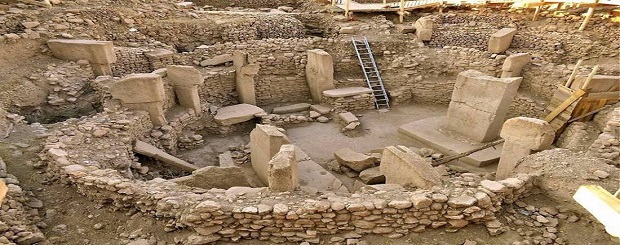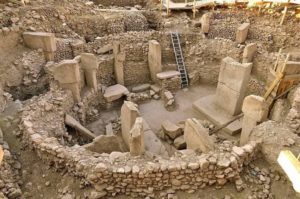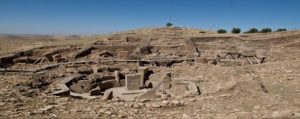
17 septembre 2017 Histoire – allinnet.info:
Aujourd’hui, beaucoup de grands scientifiques aux noms mondialement reconnus croient que l’Arménie est le berceau de la création et de la civilisation. Parmi d’autres sources, la Bible et les légendes sumériennes les plus anciennes en parlent.
Après le travail «Le culte de Dieu en Arménie», un nouveau livre intitulé «Arménie – le berceau de la création et de la civilisation» (en arménien) a été écrit, où les questions sur le culte du créateur du dieu Ar-Ara ont été à nouveau couvertes. .
Il a été publié en 2002 et republié en 2011. Nous vous proposons de lire le résumé de ce livre.
L’Arménie est l’un des plus anciens centres de civilisation. Les traces séculaires de la culture matérielle, les légendes mythologiques, les noms géographique et personnel témoignent du fait que les Arméniens sont les habitants indigènes des hauts plateaux arméniens et qu’ils y vivent depuis l’antiquité.
L’historiographie grecque a avancé sa propre version des origines arméniennes. Les chroniqueurs grecs (Hérodote, Xénophon, Strabon) considèrent que les Arméniens sont d’origine thracienne-phrygienne. L’hypothèse était basée sur leurs traditions communes, leurs vêtements, les types d’armes ainsi que sur la légende de l’Argonaute thessalien Armenos.
Dans l’historiographie médiévale arménienne (Ve-XVe siècles, M. Khorenatsi, Agatangehos, P. Byuzand, Sebeos), il était largement admis que les Arméniens, les plus anciens habitants des hauts plateaux arméniens, vivaient ici après la confusion des langues résultant de la construction de la tour de Babel.
Depuis le milieu du XXe siècle, les scientifiques, notamment les linguistes (V. Illich-Svitich, O. Shirokov, G. Klichkov, A. Dolgopolsky, V. Ivanov) ont avancé l’idée que les ancêtres des peuples appartenant aux langues indo-européennes sont les tribus indo-aryennes, qui vivaient en Asie occidentale, plus précisément dans les hauts plateaux arméniens et les régions environnantes.
Tamaz V. Gamkrelidze et V. Ivanov ont élaboré la théorie de la localisation de la patrie indo-européenne dans l’est du Proche-Orient dans le travail coopératif intitulé «Langue indo-européenne et indo-européens». Ce point de vue a de nombreux partisans et entre progressivement dans la circulation scientifique.
Dans cet ouvrage, nous avons tenté d’examiner cette version de la localisation de la patrie ancestrale des Indo-Européens dans les hauts plateaux arméniens et les régions voisines, ainsi que de l’indigénisme des Arméniens dans leur patrie.
Il existe également une théorie selon laquelle l’Arménie est le centre de la création et de la civilisation selon les idées mythologiques les plus anciennes et la Bible. Dans le travail, toutes les options pouvant confirmer cette version ont été considérées.
Les aspects archéologiques, ethnographiques et linguistiques du problème ainsi que la question des mouvements ethniques ont été révélés, en se concentrant sur l’ethnie arménienne, l’histoire et les hauts plateaux arméniens. Dans le travail, les questions du culte du dieu créateur Ar-Ara (arménien:, le Créateur) ont également été discutées.
Les sources écrites les plus anciennes (les sumériens Enki et Ninmakh, les Akkadiens Enûma Eliš (Enuma Elish), les Hurriens «À propos du royaume des cieux») attestent que des êtres humains ont été créés dans le pays d’Abzu, autrement, dans le pays de la Terre nourricière. sous les auspices de la sagesse du dieu Ea / Aya / Haya / Enki.
Ce pays est également connu sous d’autres noms – Kur, Irigal, Arali. D’après ce qui précède et d’autres sources écrites, il est évident que l’emplacement géographique d’Abzu correspond à la région où se situent les sources des fleuves Euphrate et Tigre, à savoir dans les hauts plateaux arméniens. La Bible montre également que la race humaine a été créée dans la région des sources des fleuves Euphrate, Tigre, Gehon (Araks) et Pison (soi-disant, Kura).
Les humains créés sur la terre sous le patronage du dieu Aya se considéraient comme des hays, ce qui signifie «habitant de la terre» ou «créature terrestre». Selon la mythologie hurri-arménienne («Poème du royaume des cieux», «Naissance de Vahagn»), qui serait originaire du territoire des hauts plateaux arméniens, des êtres humains auraient été créés au pays du dieu Aya par la combinaison de la mère terre d’Aya et le créateur céleste de Sun Ar (arménien:, Arev, d’où Ar / Ara).
And the inhabitant created in the Armenian Highlands, hay, combined the cult of the goddess of the Mother Earth Aya with the cult of the father, creator god Ar. The humans also considered themselves the children of god Ar.
The land where the hay-Armenians were created was named Ararat, (Armenian: արարել, ararel, English: create, hence Arar-at, place of creation), Hark, Hayk.
During a certain historical period, the Sun, the biggest and brightest light that gave people warmth and life, was considered a manifestation of the power of the creator, so hay-Armenians worshiped him as the god Ar-Ara, the Sun-god.
Thus, it can be said that by their names, the hay-Armen, the inhabitants of the Armenian Highlands, are a kind of bridge in the Universe linking the Mother Earth (goddess Aya) to the Cosmos (god-creator Ar-Ara).
At the beginning of the 3rd millennium BC, Semitic tribes, Akkadians, Babylonians, and Assyrians moved from Arabian Peninsula to northern Mesopotamia (south of the Armenian Highlands).
In the process of communicating with the inhabitants of the Armenian Highlands, where the oldest legends about the origin of the hay-Armenians were preserved, the Semitic tribes learned that they were the inhabitants of the country of the god Aya and the offsprings of the god of creation Ar. And the Akkadians also called the inhabitants of the Armenian Highlands the sons of the god Ar, that is, armand, arme (n), and their country – Armani, Arme.
Subsequently, in the 2nd-1st millennium BC, the Greeks and Persians named the inhabitants of the Armenian Highlands Armenians and the country Armenia. The work emphasizes the important role and significance of the cult of the god Ar in the creation of the spiritual and material culture of the Armenian tribes (also of other Indo-Aryan tribes). Much attention was paid to the god Ar, the god of the Sun, and to the question that Armenia is the oldest country of the cult of sun and light.
Studies show that the name, cult, and ideology of the god Ar can contribute to the study of many issues of the ancient history of Armenians (also of other Indo-European peoples), including the names of many state entities such as Aratta, Armani, Arme-Urme, Ararat-Urartu, later deities, such as Aramazd, Ahuramazda, Ares, Aras, Ram, Mars, which inherited the characteristics of the god Ar.
Questions regarding personal and geographical names are also being examined. On the Armenian plateau in the 4th-3rd millennium BC, there was a rapid development of the means of production, which in turn led to an increase in the number of people and settlements.
This fact played a big role in ethnic migrations. As a result of this process, a part of the Armenian tribes, the ancestors of the Indo-European Aryan tribes, moved to Iran, India, Greece, and other European regions (3rd-1st millennium BC), preserving the spiritual connection and remote memories of the country of their ancestors and the sacred mountain Ararat (the name of the ancient Slavic and Russian hero Svyatogor also confirms this).
They also adopted the names of their ancestors, hay, ari (Armen, armand), which contained the characteristic features of the ethnos – high, noble (hay), brave and strong (Armenian: Արի, ari, brave).
Time and space weakened the memories of their homeland, but spiritual and material values like myths, legends, traditions, as well as traces of the worship of god Ar-Ara return people to the land of light and sun, to Armenia.
The sections Armenia-Sumer, Armenia-India, Armenia-Iran, Armenia-Greece, Armenia-Britain, Armenia-Germany, Armenia-Iberian Peninsula (Spain, Baskonia) and Slavic tribes (Russians) as well as spiritual and cultural ties between them are represented in the work.
The fact that the Armenian language, in contrast to other Indo-European languages, has all the phonetic sounds specific to Indo-European languages is also interesting. Anthropological studies also show that the Armenian Highlands are in a range which an Austrian scientist von Luschan called “the birthplace of the Armenoid type.”
Thus, research gives us the opportunity to assume that the distant ancestors of the Indo-European peoples, the Aryan tribes in the Armenian Highlands, formed a tribal community with a single homeland. They worshiped the same gods (Ar-Ara, Aramazd, Vahagn, Mihr-Mitra, Anahit) and created a common culture, the heritage of which has survived to our days.
Anjela Teryan, “Ancient Written Sources of European People About Their Homeland, Armenia, and Armenians”, Yerevan, 2016 Download the full version of the book in Russian


ORIGINE SOURSES-allinnet.info/history/the-most-ancient-history-of-armenia/
TRADUCTION FRANÇAIS «lousavor avedis»
